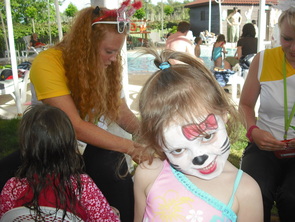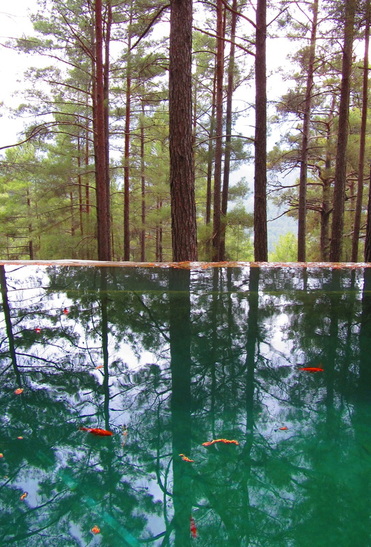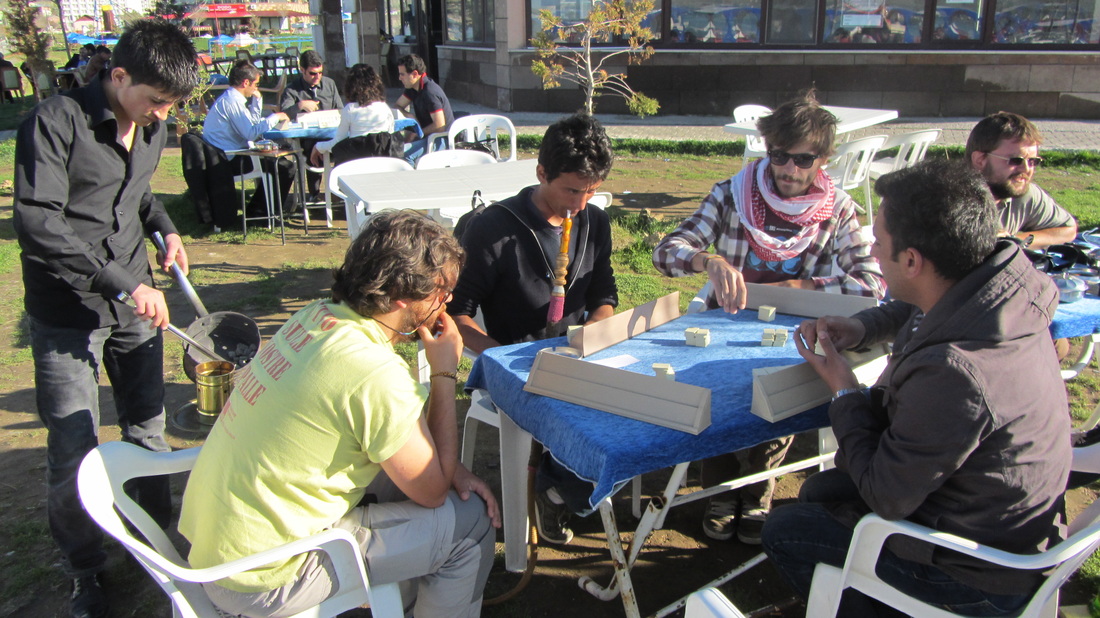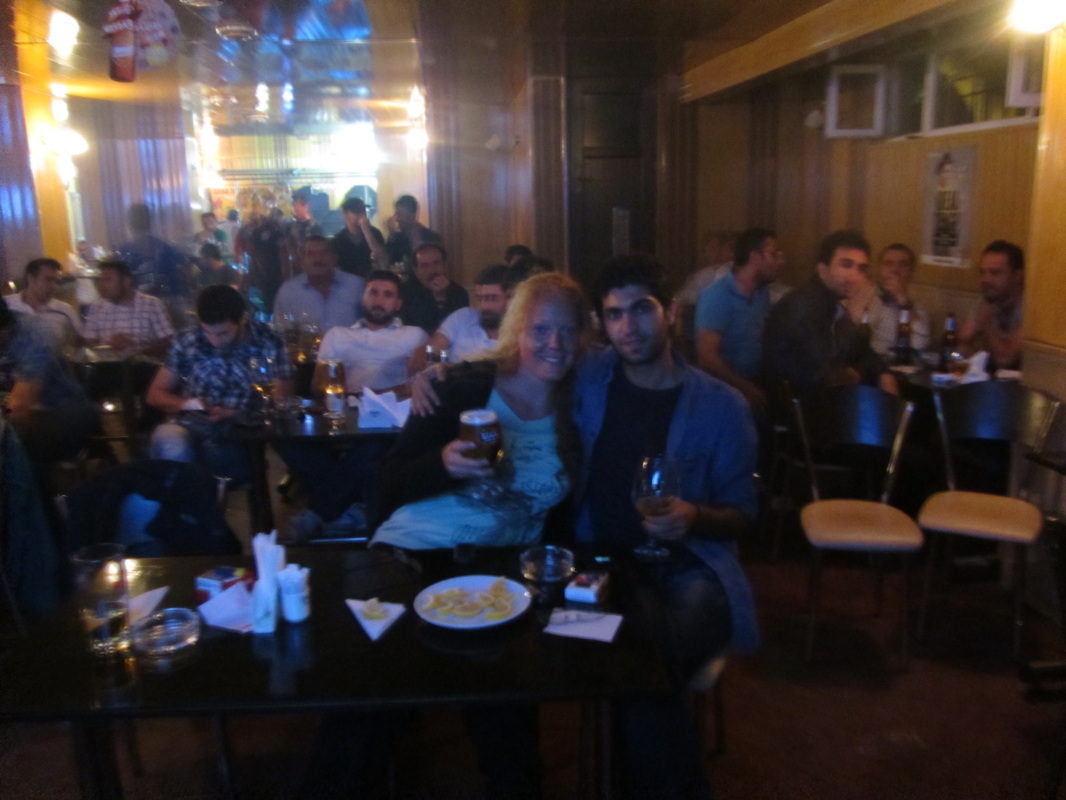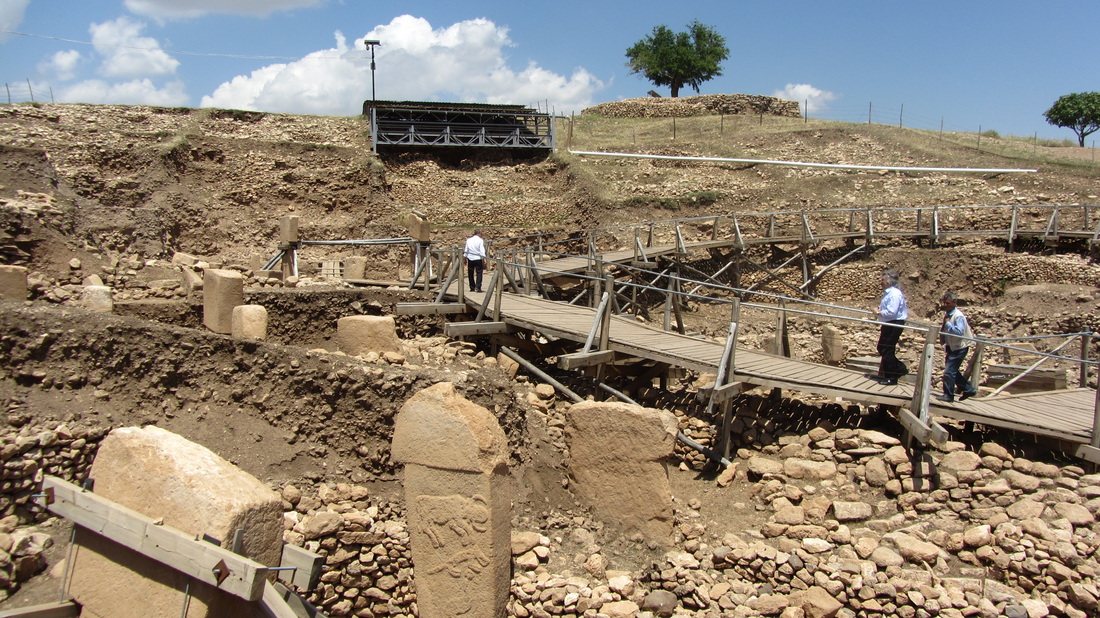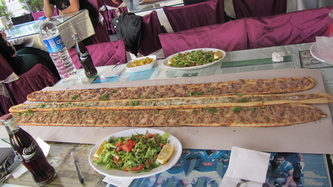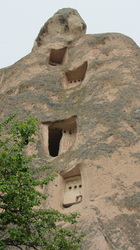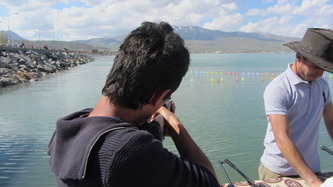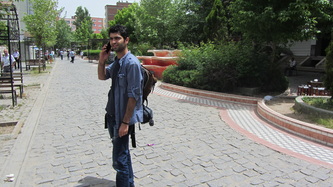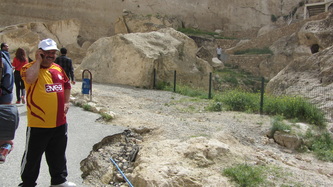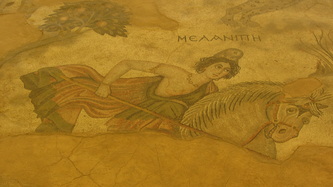Dormant Volcanos, Active Politics
21/05/2012 - East of Turkey

Rumi's Mausoleum, Konya!
After two weeks of hiking up and down the mountains of Likya, the next destination picked off the map was Hatay, the southernmost outcropping of the Turkish mainland that hugs the northeastern Mediterranean near Syria. However, as so often happens when a seemingly good hitchhiking plan is made, unforeseeable luck threw in a wild card and the original scheme never materialized – in fact I still haven’t made it to that historically rich corner of Turkey.
The coastal route eastbound passes through the notorious resort-filled tourist zone of Antalya, and it didn’t take many hitches before I was riding with two exciting guys about my age who said they were “animators” and (more importantly) that they would like to invite their tired hitchhiker for a free all-inclusive night in their resort. The previous three weeks had been spent almost exclusively sleeping under the stars and eating quick-cook couscous out of my little camping pot, so a warm bed, five-star buffet and open bar would be a very welcome change of pace. Long story short I ended up spending a month working in that tourist zone. It turns out that “animator” means “entertainer” (as opposed to cartoonist, which had been my original understanding), and after the initial one night of relaxing turned into three nights of partying, my new friends offered me an animation job in a nearby hotel. It seemed like a good idea – a few months of staying in one spot, making a little money, having some fun, plus learning languages, stage performance and the art of dealing with ignorance in a diplomatic fashion. In retrospect it should have been obvious to me that I wouldn’t last in this type of environment (as it was obvious to my friends and family); that after the initial lure of luxury and “fun” passed I would feel trapped inside an environment so removed from reality. Chalk it up to another one of life’s experiences. I held out for a month, thanks mostly to a few good people I met there, and then on a rare day off work the hitchhiking wild card came into play again and someone I had previously met called to offer a ride straight to Cappadocia. Obviously, this couldn’t be refused.
The coastal route eastbound passes through the notorious resort-filled tourist zone of Antalya, and it didn’t take many hitches before I was riding with two exciting guys about my age who said they were “animators” and (more importantly) that they would like to invite their tired hitchhiker for a free all-inclusive night in their resort. The previous three weeks had been spent almost exclusively sleeping under the stars and eating quick-cook couscous out of my little camping pot, so a warm bed, five-star buffet and open bar would be a very welcome change of pace. Long story short I ended up spending a month working in that tourist zone. It turns out that “animator” means “entertainer” (as opposed to cartoonist, which had been my original understanding), and after the initial one night of relaxing turned into three nights of partying, my new friends offered me an animation job in a nearby hotel. It seemed like a good idea – a few months of staying in one spot, making a little money, having some fun, plus learning languages, stage performance and the art of dealing with ignorance in a diplomatic fashion. In retrospect it should have been obvious to me that I wouldn’t last in this type of environment (as it was obvious to my friends and family); that after the initial lure of luxury and “fun” passed I would feel trapped inside an environment so removed from reality. Chalk it up to another one of life’s experiences. I held out for a month, thanks mostly to a few good people I met there, and then on a rare day off work the hitchhiking wild card came into play again and someone I had previously met called to offer a ride straight to Cappadocia. Obviously, this couldn’t be refused.
|
So it was back on the road and straight to the heart of amazing sights in Turkey. Cappadocia. Faerie chimneys, cave dwellers, rock churches, odd geology and a whole lot of hot-air balloons. It is another one of those places where you can feel the presence of thousands of years of different civilizations who have taken refuge in the natural safe-haven. Not to mention the presence of representatives from many current civilizations – as demonstrated by the plethora of tourists and their multi-lingual guides. My friend and I had a lovely time bouncing from one outdoor museum to another and climbing to the top of some of the “mounds” to take in impressive panoramic views (not really sure what else to call them – they were quite reminiscent of the termite mounds of sub-Saharan Africa).
|
|
After Cappadocia I decided to take a mad dash eastbound – time to check out the Kurdish side of Turkey. Besides tweaking my interests in history and natural beauty as the rest of the country had done, this area of the map also set off flags in the “happening-politics” department. Anybody who is reading this post is probably worldly enough have some familiarity with the struggle the Kurdish people have faced over the last century (their fight for rights goes back far further than that, but we can only have a brief history lesson here). Mustafa Kemal formed the Turkish nation from the smoldering post WWI remains of the Ottoman Empire, creating a new state when the occupying Allied powers of Europe had plans, via the Treaty of Sèvres, to divide the land amongst themselves (they did indeed succeed in claiming the Ottoman territory in North Africa and the Middle East). |
|
Despite Atatürk’s genius and popularity for creating something from nothing, his strict reforms were not beneficial to everyone. The Kurdish people inhabiting southeastern Turkey and adjacent regions of Iran, Iraq and Syria have been fighting for autonomy for hundreds of years, and to the end of the Ottoman Empire had reached an agreement of semi-autonomy that seemed to satisfy all sides, albeit in a shaky way. The new government of Turkey had a very different agenda, this one deeply based in Turkish nationalism and including rigorous secularization and centralization of the government in Ankara, all points that greatly marginalized the Kurdish people. They improved from semi-autonomy under the Ottoman Empire to the promise of an independent Kurdish state under the Allies’ Treaty of Sèvres, but then under Atatürk they ended up in a situation with insignificant power, severe restrictions on their language and culture, populations that had been forcefully displaced, and eventually the entire Kurdish region was placed under martial law.
|
The Turkish Oath (Andımız İngilizcesi) link here
I'm Turkish
I'm righteous I'm hard working. My principle, Is to protect my minors Is to respect my my elders Is to love my country and my nation much more than my own self. My law, Is to rise, is to go forward. O' supreme Atatürk, the creator of our today, I swear that i will walk non-stop On the path you opened, on the target you pointed out On the ideal you founded Let my existence be bestowed upon the Turkish existence Happy is the one who calls himself a Turk |
Fast forward to the modern day and images of suicide bombings and violent demonstrations by the PKK likely come to mind. Although the violence has largely subsided in recent years, the situation has not markedly improved for the Kurdish people. As I travelled around the region I got the impression that although the majority of the Kurds do not agree with the violent tactics of the PKK, they want change; and although they do seem resigned to accept the current government situation, they are not happy with it. The government has given some concessions to the Kurds in recent years but the situation remains difficult. I was very surprised to hear that, despite it being the mother tongue for the 15 million Kurds living in Turkey, the language is banned in schools and students are taught exclusively in Turkish – which until recently many didn’t understand when they began school, giving them a severe educational disadvantage in the long term. I was even more surprised, however, to hear about the daily pledge that all children in Turkey, including Kurdish children, are forced to recite before entering the classroom every morning. I have included a video of Kurdish children reciting the pledge, and the English translation. As you can imagine, for people who have been repressed by Turks and have been fighting for freedom and basic rights for as long as anyone can remember, forcing Kurdish children to claim, “I am Turkish. I am righteous. I am hard-working” and to state, “Happy is the one who calls himself a Turk” does a lot more to sow hatred and resentment than to unify a nation. Especially when it is done in such a neo-fascist militaristic style. I mean, even someone who has no clue about human psychology or politics can see that all the government is doing is continuing a multi-decade power trip and poking a stick at the pissed-off caged lion that is the 15 million-strong Kurdish population in Turkey. And just in case anyone is confused, when the pledge states “I am Turkish” it does not mean “I am a citizen of the country of Turkey”, it means “I am of Turkish ethnicity”, which Kurdish people most certainly are not – their culture, language and traditions are vastly different. Also for the record, as a Canadian I see the direct parallels to our own history with the forced integration of our aboriginal population through the horrors of residential schools (some of which were operational late into the twentieth century), and this gives me even more reason to share what I have learned. The Kurdish people I met while traveling through the east of Turkey were some of the warmest and most hospitable people I have met anywhere in the world, and that is a strong statement coming from someone who has experienced the wonders of African hospitality. The Kurdish culture deserves to be guarded.
|
|
Politics aside, my time in Turkish Kurdistan was wonderful. Upon arriving to Lake Van in the east, I decided to skip the lake’s bigger city, Van, in favor of the smaller, more picturesque Tatvan. I had also heard that there was a scenic, inactive volcano nearby that would need to be summited. I Couchsurfed in town with Ahmet, and was lucky to time my stay with a group of six young people on holiday from their volunteering job in a nearby city. We cramped into Ahmet’s apartment and then set off the next day to hitchhike to the base of Mt. Nemrut and hike through snowy avalanches to reach the volcano’s crater (note: in Turkey even hitchhiking in groups of 7 is possible). After not having hiked since Lykia more than a month before, it felt great to get the hamstrings working again, and the lakes inside the crater were truly spectacular. |
|
After Tatvan I detoured through Batman on my way towards Iraq (there is nothing of interest in Batman, except that it is called Batman and therefore completely worth a detour of several hundred kilometers). En route I hitched with Çelal and his friend Bilal who convinced me to stay in town for the night to watch the Turkish Super League Championship final, the culmination of a year’s worth of football rivalry between Fenerbahçe and Galatasaray. I was the only chick in the packed bar, but it got us front row seats so no complaints there. The game ended in a draw, but that meant Galata won the season on points, a finale that half of the very divided fan base was not too happy about. At this point I also learned that Turkish hooligans might even have surpassed their British counterparts in the department of mayhem-creation: besides the mob-like street parties in all Turkish towns and cities and the storming of the field by angry Fenerbahçe fans after the game, the Istanbul and Ankara fans managed to overturn and light several cars on fire, and even got ahold of a water canon which they filled with rocks and used to control the fun-stopping threat of riot police. Soccer is very, very important to some people.
|
|
After a night in Batman I took the road across the Tigris into Mesopotamia proper: the land between the rivers. Here Çelal took me to visit the incredible ruins of Hasenkeyf. To skip back into the political situation for just a minute, the Turkish government has plans to destroy this impressive piece of history in the near future in order to make way for a new dam project – the Kurds understandably feel this is a blow to their culture and heritage, and that if the local population was Turkish the government would take care to protect the site, instead of making plans to destroy it. From what I saw it is clear that the amount of money spent on restoration and maintenance of historical sites in the east of Turkey is significantly lower than in the west, but so are the amounts of tourists (and their tourist-dollars), so it is at least partially a chicken-or-the-egg argument.
|
|
Cizre was the last Turkish town I planned to visit before crossing into Iraq. There I stayed with Osman, another Couchsurfer, and while drinking tea and watching the sun set over the Tigris he and his friends pointed to the mountains across the river to show just how close the modern PKK guerilla bases are. He also convinced me that it would be worthwhile to put Iraq on hold for one more day so I could take the full-day detour to Șanlıurfa to visit the 12,000 year-old ruins of Gobekli Tepe – ruins that have casted considerable doubt on traditional archeological assumptions about the end of the stone age. After a slightly eventful morning of hitchhiking, which included the first time I have ever had to pull a car’s handbrake to get the driver to stop (not because I felt I was in serious danger, but because I felt that his actions and comments might lead to serious danger if I let the situation progress) I spent an hour or so visiting the small section of Gobekli Tepe that has been excavated (the rest remains carefully buried), and then decided I had a little time to hitch into town and visit a few more sites. Thanks to a wonderful ride that put the day’s scales of hitchhiking luck back into balance, the “little time” turned into several hours of touring the area, visiting such places as the Şanlıurfa Castle, Amazonian mosaıcs, Balıklı göl (sacred fish pool), an ancient monastery near one of the fırst cities to accept Christianity, and Harran – a small village that boasts the remnants of the oldest Islamic university in Anatolia and one of the most astounding castle remains I have come across anywhere (the astounding-ness of this last sight was exponentiated by the fact that it was completely empty, devoid of tourists, noise, or anything else other than the strong desert wind). To top off the wonderful day, I found a ride straight back to Cizre that culminated in drinks at a Kurdish freedom festival and an offer for a safe and direct ride the following morning to Erbil, the capital of Iraqi Kurdistan. So all in all the day’s detour totaled about 900 kilometers – it might have seemed a little daunting beforehand, but as usually happens when you take a chance at something, looking back it was obviously very worth the effort. At the moment I am in Erbil after a tour tasting Iraq’s histories – both ancient and modern. Next post coming soon, don’t forget to send a comment!
|

